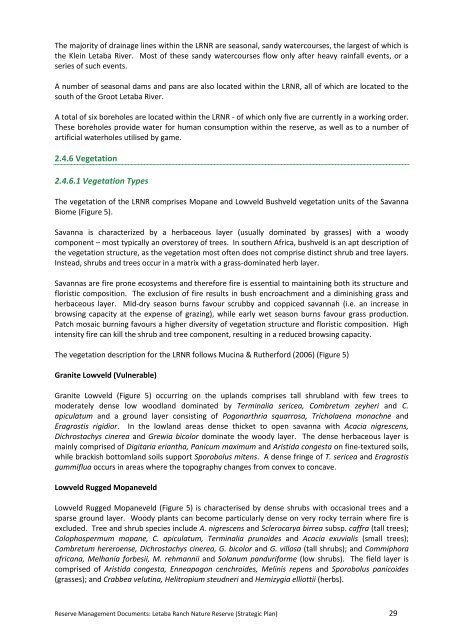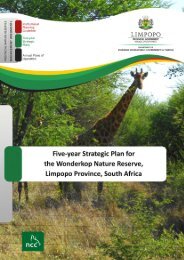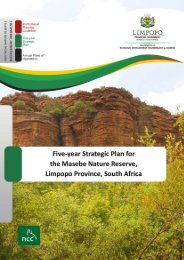Download - NCC Environmental Services
Download - NCC Environmental Services
Download - NCC Environmental Services
- No tags were found...
You also want an ePaper? Increase the reach of your titles
YUMPU automatically turns print PDFs into web optimized ePapers that Google loves.
The majority of drainage lines within the LRNR are seasonal, sandy watercourses, the largest of which isthe Klein Letaba River. Most of these sandy watercourses flow only after heavy rainfall events, or aseries of such events.A number of seasonal dams and pans are also located within the LRNR, all of which are located to thesouth of the Groot Letaba River.A total of six boreholes are located within the LRNR - of which only five are currently in a working order.These boreholes provide water for human consumption within the reserve, as well as to a number ofartificial waterholes utilised by game.2.4.6 Vegetation2.4.6.1 Vegetation TypesThe vegetation of the LRNR comprises Mopane and Lowveld Bushveld vegetation units of the SavannaBiome (Figure 5).Savanna is characterized by a herbaceous layer (usually dominated by grasses) with a woodycomponent – most typically an overstorey of trees. In southern Africa, bushveld is an apt description ofthe vegetation structure, as the vegetation most often does not comprise distinct shrub and tree layers.Instead, shrubs and trees occur in a matrix with a grass-dominated herb layer.Savannas are fire prone ecosystems and therefore fire is essential to maintaining both its structure andfloristic composition. The exclusion of fire results in bush encroachment and a diminishing grass andherbaceous layer. Mid-dry season burns favour scrubby and coppiced savannah (i.e. an increase inbrowsing capacity at the expense of grazing), while early wet season burns favour grass production.Patch mosaic burning favours a higher diversity of vegetation structure and floristic composition. Highintensity fire can kill the shrub and tree component, resulting in a reduced browsing capacity.The vegetation description for the LRNR follows Mucina & Rutherford (2006) (Figure 5)Granite Lowveld (Vulnerable)Granite Lowveld (Figure 5) occurring on the uplands comprises tall shrubland with few trees tomoderately dense low woodland dominated by Terminalia sericea, Combretum zeyheri and C.apiculatum and a ground layer consisting of Pogonarthria squarrosa, Tricholaena monachne andEragrostis rigidior. In the lowland areas dense thicket to open savanna with Acacia nigrescens,Dichrostachys cinerea and Grewia bicolor dominate the woody layer. The dense herbaceous layer ismainly comprised of Digitaria eriantha, Panicum maximum and Aristida congesta on fine-textured soils,while brackish bottomland soils support Sporobolus mitens. A dense fringe of T. sericea and Eragrostisgummiflua occurs in areas where the topography changes from convex to concave.Lowveld Rugged MopaneveldLowveld Rugged Mopaneveld (Figure 5) is characterised by dense shrubs with occasional trees and asparse ground layer. Woody plants can become particularly dense on very rocky terrain where fire isexcluded. Tree and shrub species include A. nigrescens and Sclerocarya birrea subsp. caffra (tall trees);Colophospermum mopane, C. apiculatum, Terminalia prunoides and Acacia exuvialis (small trees);Combretum hereroense, Dichrostachys cinerea, G. bicolor and G. villosa (tall shrubs); and Commiphoraafricana, Melhania forbesii, M. rehmannii and Solanum panduriforme (low shrubs). The field layer iscomprised of Aristida congesta, Enneapogon cenchroides, Melinis repens and Sporobolus panicoides(grasses); and Crabbea velutina, Helitropium steudneri and Hemizygia elliottii (herbs).Reserve Management Documents: Letaba Ranch Nature Reserve (Strategic Plan) 29
















